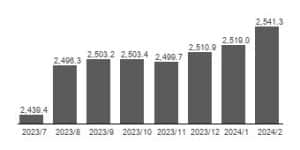Stay Ahead of the Game: Understanding the Fluctuations of the Dollar to Tanzanian Shilling Rate Today
Are you ready to stay ahead of the game and make informed financial decisions? Understanding the dollar to Tanzanian shilling rate today is essential for anyone involved in international trade or planning to travel to Tanzania. In today’s interconnected global economy, currency exchange rates can have a significant impact on profits and expenses.
In this article, we will delve into the factors influencing the dollar rate to Tanzanian shillings and how it affects various sectors. Whether you are a business owner, investor, or traveler, having a thorough understanding of currency fluctuations can empower you to make the right choices.
By keeping a close eye on the dollar to Tanzanian shilling rate today, you can anticipate potential shifts in the exchange rate and prepare accordingly. We will explore the latest trends and provide insights to help you make well-informed financial decisions.
Stay tuned to this article to gain a competitive edge in navigating the complexities of the foreign exchange market and ensure your financial success in dealings involving the Tanzanian shilling.
Factors that Influence Currency Fluctuations
The rate of dollar to Tanzanian shilling is influenced by a multitude of factors, including economic indicators, market sentiment, and geopolitical events. Understanding these factors is crucial in predicting and interpreting currency fluctuations.
One of the primary factors influencing the dollar rate to Tanzanian shillings is interest rates. When interest rates in the United States rise, it attracts foreign investors seeking higher returns on their investments. This increased demand for dollars strengthens the currency, leading to an appreciation in its value relative to the Tanzanian shilling. Conversely, when interest rates in Tanzania are higher, the Tanzanian shilling becomes more attractive, leading to an appreciation in its value against the dollar.
Another factor that affects currency fluctuations is trade balances. If Tanzania has a trade surplus, meaning it exports more goods and services than it imports, it leads to an increased demand for the Tanzanian shilling. This increased demand strengthens the currency against the dollar. On the other hand, if Tanzania has a trade deficit, meaning it imports more than it exports, it leads to an increased demand for the dollar, causing the Tanzanian shilling to weaken.
Political stability and geopolitical events can also have a significant impact on currency exchange rates. Uncertainty or instability in a country can lead to a decrease in foreign investment and a depreciation of the currency. On the other hand, positive political developments or economic reforms can boost investor confidence and strengthen the currency.
Understanding these factors and keeping a close eye on their developments can help you anticipate and respond to currency fluctuations effectively.
Historical Trends of the Dollar to Tanzanian Shilling Exchange Rate
To gain a better understanding of the dollar rate to Tanzanian shillings, it is essential to examine historical trends. Looking at past performance can provide insights into how the exchange rate has fluctuated over time and help identify patterns or trends.

Over the past decade, the dollar to Tanzanian shilling exchange rate has shown both periods of stability and volatility. In general, the Tanzanian shilling has experienced a gradual depreciation against the dollar. This depreciation can be attributed to various factors, including inflation, economic conditions, and external market forces.
In recent years, the exchange rate has been relatively stable, with minor fluctuations. This stability can be attributed to several factors, including improved economic stability in Tanzania, increased foreign direct investment, and prudent monetary policies by the central bank.
However, it is important to note that past performance does not guarantee future results. Currency exchange rates are highly unpredictable and can be influenced by unforeseen events or economic developments. Therefore, it is crucial to stay informed about the current market conditions and factors influencing the exchange rate.
Understanding the Impact of Currency Fluctuations on the Economy
Currency fluctuations can have a significant impact on the economy of a country, including Tanzania. Understanding these impacts is crucial for businesses, investors, and policymakers.
One of the primary impacts of currency fluctuations is on importers and exporters. When the Tanzanian shilling weakens against the dollar, it becomes more expensive for importers to purchase goods and services denominated in dollars. This can lead to increased costs for businesses and potentially higher prices for consumers. On the other hand, exporters benefit from a weaker currency as it makes their goods and services more competitive in international markets.
Currency fluctuations also affect foreign direct investment (FDI) and tourism. When the Tanzanian shilling strengthens against the dollar, it can deter foreign investors as their returns may be eroded when converted back into their home currency. Conversely, a weaker currency can attract foreign investors looking for investment opportunities in Tanzania. Similarly, a weaker currency can make Tanzania a more affordable destination for tourists, boosting the tourism industry.
Additionally, currency fluctuations can impact inflation and interest rates. When the Tanzanian shilling depreciates, it can lead to higher import costs, which can fuel inflationary pressures. To combat inflation, the central bank may increase interest rates, which can have implications for businesses and consumers.
Understanding the impact of currency fluctuations on the economy is crucial for businesses and investors to strategize and make informed decisions. By analyzing these impacts, stakeholders can identify opportunities and mitigate risks.
Strategies for Managing Currency Fluctuations
Managing currency fluctuations is essential for businesses and investors to mitigate risks and maximize returns. Here are some strategies to consider:
- Hedging: Hedging involves using financial instruments such as forward contracts or options to protect against adverse currency movements. By locking in an exchange rate in advance, businesses and investors can reduce their exposure to currency fluctuations.
- Diversification: Diversifying currency exposure can help mitigate the impact of currency fluctuations. For businesses, this can involve sourcing inputs from multiple countries to reduce dependence on a single currency. For investors, diversifying their investment portfolio across different currencies can help spread risks.
- Monitoring and Forecasting: Keeping a close eye on the currency market and using forecasting tools can help anticipate potential shifts in the exchange rate. This information can be valuable in making timely decisions and taking advantage of favorable exchange rates.
- Collaboration: Working closely with financial institutions and currency experts can provide valuable insights and guidance in managing currency fluctuations. These experts can provide advice on hedging strategies, market trends, and risk management.
By implementing these strategies, businesses and investors can effectively manage currency fluctuations and reduce their exposure to risks.
Tools and Resources for Tracking the Dollar to Tanzanian Shilling Exchange Rate
To stay informed about the dollar rate to Tanzanian shillings, there are several tools and resources available:
- Currency Converter Apps: Currency converter apps provide real-time exchange rate information and allow you to convert currencies on the go. Popular apps include XE Currency, OANDA Currency Converter, and Currency Converter Plus.
- Financial News Websites: Financial news websites such as Bloomberg, Reuters, and CNBC provide up-to-date information on currency exchange rates, market trends, and economic developments.
- Central Bank Websites: Central banks, such as the Bank of Tanzania, provide information on official exchange rates, monetary policies, and economic indicators. These websites can be valuable sources of information for tracking the Tanzanian shilling.
- Currency Exchange Platforms: Online currency exchange platforms, such as TransferWise, provide competitive exchange rates and allow you to transfer money internationally. These platforms often provide real-time exchange rate information and allow you to set up rate alerts.
By utilizing these tools and resources, you can stay informed about the dollar to Tanzanian shilling exchange rate and make well-informed financial decisions.
Tips for Making Informed Decisions in Foreign Exchange Transactions
When engaging in foreign exchange transactions involving the Tanzanian shilling, it is essential to make informed decisions to minimize risks and maximize returns. Here are some tips to consider:
- Research and Analysis: Conduct thorough research and analysis of the currency market before making any transactions. Understand the factors influencing the exchange rate and assess the potential risks and rewards.
- Set Realistic Goals: Set realistic goals for your foreign exchange transactions and align them with your overall financial objectives. This will help you make informed decisions and avoid impulsive trading.
- Consider Timing: Timing is crucial in foreign exchange transactions. Monitor the market closely and consider the timing of your transactions to take advantage of favorable exchange rates.
- Seek Expert Advice: If you are unsure about foreign exchange transactions, seek advice from currency experts or financial institutions. They can provide valuable insights and guidance to help you make informed decisions.
- Manage Risks: Implement risk management strategies, such as hedging or diversification, to mitigate the impact of currency fluctuations. Assess your risk tolerance and develop a risk management plan accordingly.
By following these tips, you can navigate the foreign exchange market with confidence and make informed decisions that align with your financial goals.
Expert Opinions on the Future of the Dollar to Tanzanian Shilling Exchange Rate
While the rate of dollar to Tanzanian shilling is inherently unpredictable, experts and analysts often provide opinions and forecasts based on their analysis of economic indicators and market trends. Here are some expert opinions on the future of the dollar to Tanzanian shilling exchange rate:
- Economic Outlook: Many experts believe that the Tanzanian economy is poised for steady growth, which could lead to a stronger Tanzanian shilling in the long term. Factors such as increased foreign direct investment, infrastructure development, and economic reforms are expected to contribute to this growth.
- Inflation and Monetary Policies: Experts suggest that the central bank’s monetary policies and inflation management will play a crucial role in shaping the exchange rate. Effective inflation control measures can help stabilize the currency and attract foreign investors.
- Global Economic Factors: Global economic factors, such as changes in interest rates, trade policies, and geopolitical events, can have a significant impact on the dollar to Tanzanian shilling exchange rate. Experts recommend monitoring these factors and their potential implications for the exchange rate.
It is important to note that these expert opinions are based on current information and analysis, and they may change as new developments unfold. Therefore, it is crucial to stay updated and consider multiple perspectives when assessing the future of the exchange rate.
Economic Indicators to Watch for Predicting Exchange Rate Movements

Monitoring economic indicators can provide insights into potential exchange rate movements. Here are some key economic indicators to watch when predicting the dollar to Tanzanian shilling exchange rate:
- Interest Rates: Changes in interest rates can have a significant impact on exchange rates. Monitor the interest rate differentials between the United States and Tanzania, as well as any changes in monetary policies.
- Inflation Rates: Inflation rates can influence the purchasing power of a currency and, consequently, its exchange rate. Monitor inflation rates in both countries and assess their potential impact on the exchange rate.
- Trade Balances: Trade balances, specifically the balance of payments and current account balances, can provide insights into the supply and demand dynamics of currencies. Monitor trade data to assess the potential impact on the exchange rate.
- GDP Growth: Economic growth is often correlated with currency strength. Monitor GDP growth rates in both countries and assess their potential implications for the exchange rate.
- Political and Geopolitical Developments: Keep an eye on political and geopolitical developments as they can impact investor sentiment and currency exchange rates. Monitor news and events that can potentially influence the exchange rate.
By tracking these economic indicators, you can gain a better understanding of potential exchange rate movements and make informed decisions.
Navigating the Dollar to Tanzanian Shilling Exchange Rate
Understanding the fluctuations of the dollar rate to Tanzanian shillings is crucial for businesses, investors, and travelers alike. By analyzing the factors influencing currency fluctuations, monitoring market trends, and utilizing tools and resources, you can stay ahead of the game and make well-informed financial decisions.
While currency exchange rates are inherently unpredictable, staying informed about economic indicators, expert opinions, and geopolitical developments can provide valuable insights into potential exchange rate movements. By adopting risk management strategies and seeking expert advice when needed, you can navigate the complexities of the foreign exchange market and ensure your financial success in dealings involving the Tanzanian shilling.
Stay ahead of the game, stay informed, and make the most out of your financial endeavors involving the dollar to Tanzanian shilling rate today.
For more articles related to Financial Services in Tanzania, click here!































